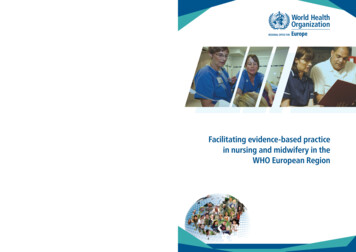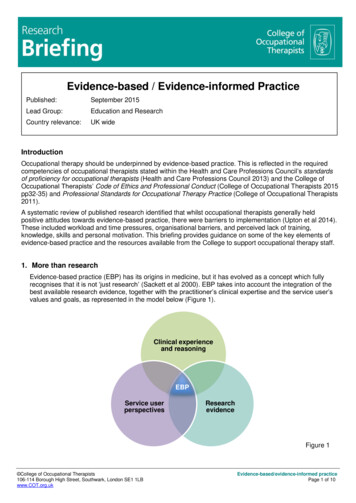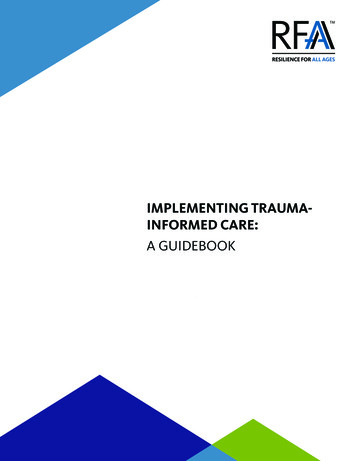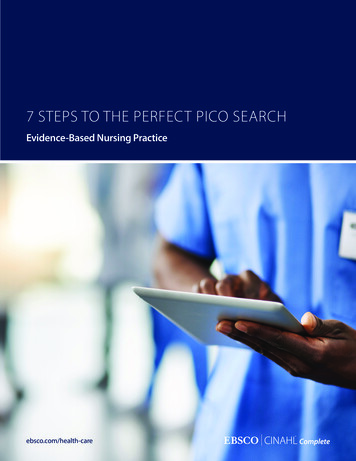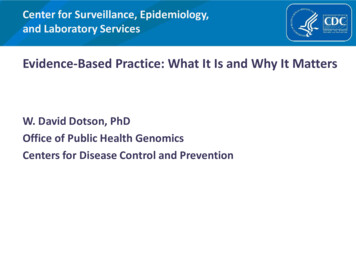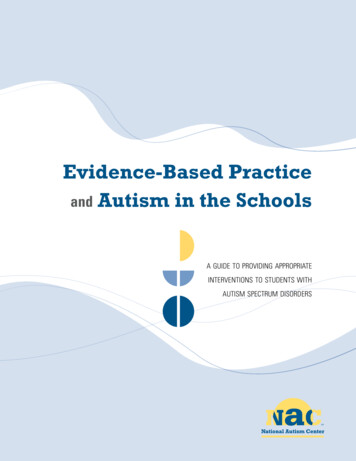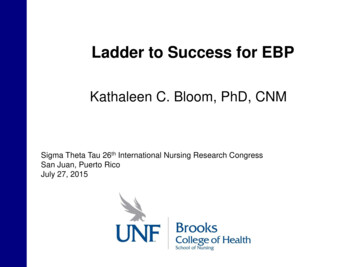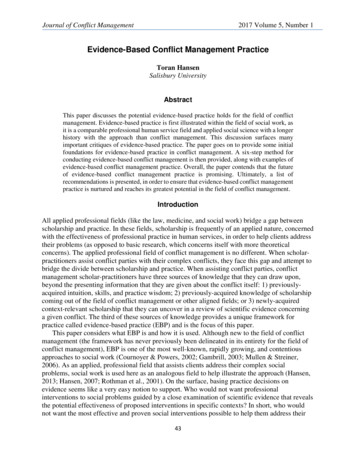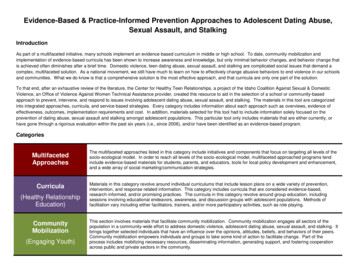
Transcription
Evidence-Based & Practice-Informed Prevention Approaches to Adolescent Dating Abuse,Sexual Assault, and StalkingIntroductionAs part of a multifaceted initiative, many schools implement an evidence-based curriculum in middle or high school. To date, community mobilization andimplementation of evidence-based curricula has been shown to increase awareness and knowledge, but only minimal behavior changes, and behavior change thatis achieved often diminishes after a brief time. Domestic violence, teen dating abuse, sexual assault, and stalking are complicated social issues that demand acomplex, multifaceted solution. As a national movement, we still have much to learn on how to effectively change abusive behaviors to end violence in our schoolsand communities. What we do know is that a comprehensive solution is the most effective approach, and that curricula are only one part of the solution.To that end, after an exhaustive review of the literature, the Center for Healthy Teen Relationships, a project of the Idaho Coalition Against Sexual & DomesticViolence, an Office of Violence Against Women Technical Assistance provider, created this resource to aid in the selection of a school or community-basedapproach to prevent, intervene, and respond to issues involving adolescent dating abuse, sexual assault, and stalking. The materials in this tool are categorizedinto integrated approaches, curricula, and service-based strategies. Every category includes information about each approach such as overviews, evidence ofeffectiveness, outcomes, implementation requirements and cost. In addition, materials selected for this tool had to include information solely focused on theprevention of dating abuse, sexual assault and stalking amongst adolescent populations. This particular tool only includes materials that are either currently, orhave gone through a rigorous evaluation within the past six years (i.e., since 2006), and/or have been identified as an evidence-based Healthy ng Youth)The multifaceted approaches listed in this category include initiatives and components that focus on targeting all levels of thesocio-ecological model. In order to reach all levels of the socio-ecological model, multifaceted approached programs tendinclude evidence-based materials for students, parents, and educators, tools for local policy development and enhancement,and a wide array of social marketing/communication strategies.Materials in this category revolve around individual curriculums that include lesson plans on a wide variety of prevention,intervention, and response related information. This category includes curricula that are considered evidence-based,research-informed, and/or promising practices. The curricula in this category revolve around group education, includingsessions involving educational endeavors, awareness, and discussion groups with adolescent populations. Methods offacilitation vary including either facilitators, trainers, and/or more participatory activities, such as role playing.This section involves materials that facilitate community mobilization. Community mobilization engages all sectors of thepopulation in a community-wide effort to address domestic violence, adolescent dating abuse, sexual assault, and stalking. Itbrings together selected individuals that have an influence over the opinions, attitudes, beliefs, and behaviors of their peers.Community mobilization empowers individuals and groups to take some kind of action to facilitate change. Part of theprocess includes mobilizing necessary resources, disseminating information, generating support, and fostering cooperationacross public and private sectors in the community.
Definitions Evidence-based programs: Includes materials, initiatives, and/or approaches that have either gone through a rigorous formal evaluation, shown a record ofpositive outcomes, considered research-informed, or have been identified by the Substance Abuse and Mental Health Administration (SAMHSA) as an“evidence-based program”. In order to achieve similar outcomes to past evaluations, implementations should maintain fidelity and mirror previousmethodologies of data collection. Promising Practices: Included materials, initiatives, and/or approaches that are currently undergoing a formal evaluation or were created based on wellknown theories of change. Promising practices can also include materials that have been identified by the Center for Disease Control (CDC) as a “promisingpractice”.Additional ConceptualizationsLevels of Prevention: Primary Prevention: Activities of a program that focuses on eluding stalking, sexual assault, and abuse in a dating relationship before the first instanceoccurs. Primary prevention usually targets the entire population within a school or community consortium. Objectives of primary prevention programs mayinvolve increasing protective factors and the reduction of risk factors towards those individuals most likely to later become involved in abusive relationships,sexual assault or stalking. Secondary Prevention: Initiatives that are designed to address violence that is already occurring in a relationship. Secondary prevention programsgenerally target at-risk individuals who have exhibited abusive behaviors or possess certain risk factors that are associated with domestic violence, datingabuse, sexual assault, and/or stalking. Tertiary Prevention: Interventions involving direct services to individuals who have already, or are currently, experienced domestic violence, dating abuse,sexual assault, and/or stalking. Tertiary prevention programs attempt to minimize relationship abuse, sexual assault, and stalking once it has alreadyoccurred.Audience to be impacted by Efforts: Universal Approach: Addresses the entire population with messages and programs aimed at prevention or delaying problem behaviors. Targeted Approaches: Selecting subsets of the total population that are assessed as at risk for problem behaviors by virtue of their membership in aparticular population segment. In addition, these initiatives provide resources for specified populations that may warrant unique or tailored approaches. Indicated Approaches: Identify individuals who are exhibiting early signs of problem behavior(s) and target them with special programs to prevent futureexposure to violence or abuse in middle and high school.
Evaluation Terms: Program Evaluation: The uses of systematic research procedures to collect, analyze, and use information to determine the effectiveness of a particularprogram. Outcome Evaluation: Outcomes are specific attitudes, knowledge, behaviors, or skills of the target population in which the program aims to have a positiveinfluence. An outcome evaluation investigates whether these changes occur in the participating target population and if these changes are associated with aprogram or an activity. Such evaluations examine whether, to what extent, and in what direction outcomes change for those in the program. Process Evaluation: An evaluation that determines whether a program or curriculum was implemented with design. Process evaluations answer questionssuch as what was done, when, by whom, and to whom. Process evaluations are important in that they provide information that can be used to enhance thequality of the program by ensuring the total quality of the program is being captured in its implementation. Rigorous Evaluation: A process and outcome evaluation consisting of quantitative, pre- and post-testing, control group or regression (time-series data)analysis, analysis of statistical significance, adequate sample size, and /or systematic qualitative data with clear analytical discussion and indications ofvalidity.Additional Note:Although some of the programs are still in the midst of ongoing evaluations, emerging research suggest the use of curriculums grounded in social and emotionallearning as a supplemental materials to effective behavioral change. Social and emotional learning curriculums engage students with skills revolving aroundrecognizing and managing emotions, developing empathy, establishing positive relationships, making responsible decisions and handling challenging situationsconstructively and ethically.
Multi-Faceted ApproachesMiddle SchoolDating Matters: Strategies to Promote Healthy Teen RelationshipsProgram DetailsProgram ObjectivesDating Matters employs a comprehensivepublic health approach to teen dating abuseprevention at each level of the thth 6 grade and 7 grade students areexposed to a researched informedcurriculum created by the CDC.th 8 grade students participate in SafeDates, an evidence-based classroomcurriculum focusing on preventingpsychological, physical, and sexualviolence among adolescentpopulations.thth 6 and 7 grade parents participate inParents Matter! – a curriculum thatpromotes effective parent-childcommunication on healthy relationshipand sexual development topics.th 8 grade parents participate inFamilies for Safe Dates – an evidencebased curriculum that focuses onparent-child interactions and fostersdiscussion of teen dating abuse. Educators participate in a free, onlinetraining regarding risk and protectivefactors for teen dating abuse and theirrole in promoting healthy od Community-wide communicationscampaign including social media,Short Message Service (SMS), and abrand ambassador program. Policy package on how to best informteen dating abuse prevention policies.ImplementationTarget Audience Middle school(ages 11-14)Sessions 23 total forstudentsthth- (across 6 , 7 ,thand 8 grade) 12 total forparentsthth- (across 6 , 7 ,thand 8 grade)Evidence ofEffectivenessCurrentlyundergoing arigorousevaluation by theCDC. Evaluationfrom 2011 –2015Strengths& BarriersCostStrengthsIncorporates an evidencebased curriculumDepending on the results of the evaluation,the large majority of the materials will beoffered free of charge.BarriersLimitations with empiricalresearch evaluations. Onlythe educator training andSafe Dates program areavailable. Evaluations onother program componentswill not be available until2015.Safe Dates will cost 225.00. Thecurriculum includes: Updated statistics and facts Information on dating abuse throughtechnology All handouts and parent resources onCD-ROM New Families for Safe Dates programto get families talking about healthydating relationships and dating abuse 50 min each Presented tomixed genderaudiencesClassroomIntegration During schoolMeasureableComponent UndeterminedTraining UndeterminedApproach UniversalSafe Dates ates.pageDating Matters tingmatters/index.html
Shifting BoundariesProgram DetailsProgram Objectives Reduce dating violenceand sexual harassmentamong adolescentpopulations Increase knowledgeand awareness ofdating violence andsexual harassmentthrough a school widesocial marketingcampaign Identify “hot spots”within the school andincrease staffsupervision within theidentified areasImplementationTarget Audience: Middle SchoolSessions 6 total 45 minutes each Presented to mixedgender audiencesClassroom Integration: Flexible lessons to beimplemented in a healthclassMeasureable Component: UndeterminedTraining Each component of thecurriculum includes userfriendly instructions anddirectionsApproach UniversalEvidence ofEffectivenessTaylor et al., 2011 conducted a twoyear, mixed-methodologicalrigorous evaluation of shiftingboundaries. Findings from theevaluations evaluationdemonstrated: Increased knowledge andawareness of sexual abuse andharassment Increased prosocial attitudes anda negative view of datingviolence and sexual harassment Promoted nonviolent behavioralintentions in bystandersStrengths& BarriersStrengths:Curricula is flexible and can beimplemented over 6 to 10 weeks.Barriers: Evaluation was conductedwithin middle schools inlarge urban areas in onestate only. Results of rigorousevaluation may not begeneralizable to rural orsuburban areas. There is no faculty and stafftraining componentCostThere is no cost to thecurriculum. For moreinformation, contact:Bruce 9512Or Reduction of sexual harassment(victimization and perpetration by26-34% six months post followupNan D. Stein Reduced victimization andperpetration of physical andsexual dating violence by about50% up to six months after theintervention.Telephone: 32‐47% lower peer sexualviolence victimization andperpetration up to six monthsafter the 2
Multi-Faceted ApproachesMiddle & High SchoolThe Green Dot StrategyProgram DetailsProgram Objectives Targets all members of the community aspotential bystanders through peer andcultural influences across the socioecological model. Engages bystanders through awareness,education, and skills-practice with pro-activeand safe reactive bystander interventions. Utilizes influential members of thecommunity; engages and educatesinfluential members by equipping them withtools and skills to establish new normswithin their sphere of influence. Engages influential members of thecommunity to facilitate in a social movementthat harnesses the power of peer influenceand individual bystander choices to createlasting culture change, resulting in areduction of power-based personalviolence. Utilizes a social marketing campaign tofacilitate the social movement.ImplementationTarget Audience Middle school, highschool & collegeSessions Overview speeches- Numbers may vary- 15 – 50 minutes each 1 bystander training- 8 hours Presented to mixedgender audiencesClassroom Integration AdaptableMeasureable Component UndeterminedTraining The Green Dot overviewspeeches and trainingscan only be carried out bycertified trainers.Implementers shouldbecome certified byattending a four-day trainthe trainer.Approach UniversalEvidence ofEffectivenessHigh school strategycurrently undergoing arigorous evaluation bythe CDC. Evaluation from2011 – 2014Other Evidence: Implemented inover 60 collegesnationwide Implemented inover 26 highschools throughoutKentucky Coker et al., 2011found that thetrained studentshad significantlylower rape/mythacceptance scores.Trained studentsalso reportedengaging in morebystanderbehaviors whencompared with nontrained students.Strengths& BarriersStrengthsWhen fully implementedusing all components, amultifaceted adolescentdating abuse programcan be achieved.Strategy includes skillbuilding componentswhere students can testout selected bystanderapproaches and provideand receive feedback.Barriers Planning intensive. Evaluation occurringwithin Kentuckyschools only (limitsexternal validity)CostThe cost varies based on amultitude of factors. Forpricing information, contactJennifer Sayre 19.0913
Respect WORKS!Program DetailsProgram ObjectivesAddresses adolescent dating abuse andincorporates four components: Safe Dates - an evidence-based curriculumo Raise student awareness of whatconstitutes healthy and abusive datingrelationships.o Raise student awareness of dating abuseand its causes and consequences.o Equip students with the skills andresources to help themselves or friends inabusive dating relationships.o Equip students with the skills to develophealthy dating relationships, includingpositive communication, angermanagement, and conflict resolution.ImplementationEvidence ofEffectivenessTarget Audience: Middle & high schoolThe entire approach hasnot been evaluated. SafeDates (2005) and EndingViolence (2006) have bothendured a rigorousevaluation.SessionsSafe Dates 9 sessions- 50 min each- Play- ParentalcomponentsEnding Violence 3 sessions- 45 – 60 minuteseachClassroom Integration Adaptable Break the Cycle’s School Policy Kito Prepares schools to meet standards ofschool safety and legal liability.MeasureableComponent Undetermined Ending Violence (interactive DVD –basedcurriculum)o Participants understand legal rights andresponsibilitieso Creates a framework for building healthyrelationships in the future.Training Each componentincluded userfriendly instructionsand directions Approach UniversalSpeak.Act.Change Youth Advocacy Kito Develop the next generation of antiviolence advocates.o Learn about leadership and other positiveyouth development skills.Safe Dates: Decreased physical,sexual, and seriousphysical violenceperpetration Decrease sexualviolence and datingabuseEnding Violence Increase in knowledge oflaws related to datingabuse – retained up to 6months later Increased knowledgeabout attorneys,proclivity to seek legalassistance, andperceived helpfulness ofthe professionalsStrengths& BarriersStrengthsMultifaceted approachaimed at raisingawareness, changingattitudes and behaviors,and providing adolescentswith tools and skills topromote healthyrelationships. Userfriendly materials.BarriersSafe Dates Evaluation wasconducted in rural areasin one state only in 2005School Policy Kit No evaluation has beenconducted Initiatives more responsethan prevention basedSpeak.Act.Change No outcome dataEnding Violence Did not changebehaviors No change in maleperpetrated violence Sample included Latinoyouth onlyCost 340.00 for the completeRespect WORKS! model.Includes: Safe Dates,School Policy Kit, EndingViolence, andSpeak.Act.Change. Referto website forsupplemental materialsAvailable at:Break the il:info@breakthecycle.org.Telephone:202.824.0707
Expect RespectProgram DetailsProgram ObjectivesExpect Respect is an ecologically informedschool-based program aimed at preventingdating abuse and sexual violence in an effort tobuild healthy relationships among adolescents,develop youth leadership, and increase safetyand respect on school campuses. Build skills for healthy relationships- Increase social support- Decrease victimization and perpetrationMobilize teen leaders- Engage and empower youth as positiverole models and peer educators- Increase active bystander behavior- Increase awareness through media andsocial marketing --Engage important adults in teens’ livesEducate school personnel, parents andother adultsCreate positive in and afterschoolenvironmentsEngage local artists and artsorganizations in community-wide eventsthat inspire youth and adultsModel and teach healthy relationshipskillsImplementationTarget Audience Middle & high school- Grades 6 - 12SessionsSupport Group Curriculum 24 total 50 – 60 minutes each Presented to gendersseparatelyYouth LeadershipCurriculum 8 lessonsClassroom Integration Health English Art After school settingsMeasureable Component Pre/Post SurveysTraining 12 hour training forimplementers/facilitatorsApproach Universal (YouthLeadership Curriculum) Indicated (SupportGroup Curriculum)Evidence ofEffectivenessStrengths& Barriers Ball et al., 2009conducted a qualitativeevaluation of thecurriculum used in thesupport groups (Book I).Outcomes showed:- Increase in healthyconflict resolution skills- Increase in ability toidentify abusiverelationships- Reduced perpetrationamong high riskparticipantsStrengthsUser-friendly materials,comprehensiveapproach to adolescentdating abuse Ball et al., 2012conducted a quantitativeevaluation of thecurriculum used in thesupport groups (Book I).Outcomes showed:- Increase in healthyconflict resolution skillsBarriers No rigorousevaluation Evaluations of thecurriculum only andnot the fullimplementation of allthree componentstogether No decrease inperpetration/victimization acrossthe full sampleCost 160.00 for all four books (program overview, books I, II,and III) and a CD with programforms and handoutsTo discuss training options:Contact Barbara BallE-mail:bball@SafePlace.orgTelephone: 512.356.1623orBarri e: 512.356.1628
CurriculaHealthy Relationships EducationMiddle SchoolSecond Step: Student Success Through PreventionProgram DetailsProgram OverviewA prevention program thatteaches socio-emotional skillsaimed at reducing impulsiveand aggressive behavior whileincreasing social competence.This program focuses onteaching empathy andcommunication, emotionmanagement and coping skillsand effective decision making.These skills are essential tohelping students stay engagedin school, make good choicesand form healthy relationships.In addition, the second stepprogram also providesstudents with the skills andtools needed to set goals andavoid peer pressure,substance abuse, bullying andcyber bullying.ImplementationTarget Audience: Middle SchoolSessions 13 – 15 total per grade 25 - 45 minutes each Presented to mixed genderaudiencesClassroom Integration: Language arts, theatre,civics, science, math, healthand life skillsMeasureable Component: Formative and summativeassessmentsTraining Free online trainingApproach UniversalEvidence ofEffectivenessStrengths& BarriersCost Designated as an evidencebased program by theSAMHSA. Also selected forthe National Registry ofEvidence-based Programsand Practices (NREPP).Strengths:Second Step incorporatesinnovative and engagingactivities that facilitate thedevelopment of importantsocial and emotional skills. Thecurriculum is user friendly andcan be easily incorporated intoa wide variety of academiclessons. Provides familymaterials in both English andSpanish to send home toparents.Program can be purchased ina complete kit (grades 6, 7, &8) for 919.00. The totalprogram includes: Lessons plans Grade-Level LessonCompanion DVD Posters for each grade Academic integrationactivities Reproducible homeworkand Family Letters Formative and summativeassessments Grounded with researchedbased theories and findingsfocusing on identified riskand protective factors thatwork to diminish thelikelihood of students’involvement in riskybehavior An estimated 32,000schools across the UnitedStates have implementedSecond Step since theprogram's inception in 1987.Since 2004, nearly 8 millionstudents and 2 millionadults have participated inthe Second Step program(based on studiesconducted with K – 5students only).Barriers:Although this program hasbeen rigorously evaluated, thestudies primarily focused onpre-elementary andelementary populations.Therefore, the findings are notcommensurate to the desiredoutcomes of middle schoolstudents’ development andimplementation of social andemotional skills.Curricula can be purchased byeach grade level as well for 339.00 .aspx.Telephone206.343.1223
CurriculaHealthy Relationships EducationMiddle & High SchoolThe Fourth “R”Program DetailsthProgram Objectives (Overall for 7 th12 ) - -- --Personal safety and injurypreventionDemonstrate active listening skillswhen managing conflictDescribe specific types of physicaland non-physical abuseDescribe solutions and strategies toaddress abuse and violence in thelives of young peopleHealthy growth and sexualityDemonstrate understanding ofpressure on teens to be sexuallyactiveDemonstrate understanding of theimpact of parents, the media, andculture on values and goals relatedto healthy active livingSubstance use and abuseDemonstrate and use bothdecision-making and assertive skillswith respect to media influencesand peer pressure related toalcohol, tobacco, and other drugsProduce sequential action plans toachieve personal goalsImplementationEvidence ofEffectivenessStrengths& BarriersCostTarget Audience Middle and high schoolstudents (grades 7-12,program topics varybased on grade level)Evidence-based practice.This program endured arigorous evaluation byCrooks et al., 2011 & Wolfeet al., 2009.StrengthsIncludes examples of everydayteen conflicts that occur both inand out of dating relationships.Gender inclusive and culturallycompetent. Teacher friendly(scripted, clear scope andsequence of lessons, offerssuggestions for adaptations forstudents with diverse needs). 175.00 – 695.00: Grade 9 &10 health education curriculumwith learning goals, activitiesand procedures andknowledge quizzesBarriersLimitations with empiricalresearch evaluations: 295.00 includes:- Curriculum Kit Binders 5 copies of laminatedresources 1 CD RomSessions 21 total 75 minutes each Presented to mixedgender audiencesClassroom Integration Health, P.E., English &after school programsMeasureableComponent NoneTraining Facilitators need to gothrough one 8-hourtraining by a MastertrainerTarget Approach Universal Implemented in over1,200 schools since2004 Reduction in datingviolence 2.5 years afterparticipating in program Increased condom useof sexually active males Increase in knowledgeand awareness of datingviolence, substance use,& sexual health Increase incommunication skills Class room sessions werenot observed by anindependent rater- Could have had an effecton fidelity Students in Wolfe et al.,2009 were predominantlywhite. Rigorous evaluation wasconducted with Canadianstudents only- Not generalizable to U.Scultures and values 175.00 includes:- Teacher Binders 3 binders 3 units 695.00 includes:- Comprehensive kit binders 5 copies of laminatedresources 1 CD Rom 6 DVD resourcesContact a519.858.5154
Safe DatesProgram DetailsProgram Objectives Raise student awareness ofwhat constitutes healthy andabusive dating relationships. Raise student awareness ofdating abuse and its causesand consequences. Equip students with the skillsand resources to helpthemselves or friends inabusive dating relationships. Equip students with the skillsto develop healthy datingrelationships, includingpositive communication,anger management, andconflict resolution.ImplementationTarget Audience Middle and high schoolstudents (grade 7-12)Sessions 9 total 50 Minutes Presented to mixed genderaudiencesClassroom Integration Health, P.E., English &after school programsMeasureable Component Fidelity checklistTraining 8 hours of training- Recommended, notrequiredApproach UniversalEvidence ofEffectivenessDesignated as a model program bythe SAMHSA. Also selected for theNational Registry of Evidence-basedPrograms and Practices (NREPP).Multiple evaluations and the parentcomponent, Families for Safe Dates,is currently undergoing a rigorousevaluation (2011-2014) funded bythe CDC.Outcomes from Foshee et al., 1998,1999, 2001, 2004, & 2005 showed: Decreased physical and sexualviolence perpetration Decreased sexual and datingviolence victimization Stronger communication and angermanagement skills Less gender stereotyping Increased awareness ofcommunity resourcesStrengths& BarriersStrengthsStrong outcomes whenimplemented with fidelity.Includes a fidelity checklist.Materials and user manual isuser friendly.BarriersLimitations with empiricalresearch evaluations. Last evaluation of curriculumonly was in 2005 in ruralareas and one state. Results of rigorousevaluation may not begeneralizable to urban orsuburban areas.Cost 225.00 includesinstructor’s manualand CD with programforms, handouts andparent resources.Available fromHazelden r651.213.4200
Coaching Boys Into MenProgram DetailsProgram Objectives Build skills throughsocial norm changetheory to increasebystander behaviorrelated to domesticviolence preventionImplementationTarget Audience: High schoolSessions 12 total 10-15 minutes each Male students onlyClassroom Integration: Short lessons beforepractice to be done inthe gym, classroom, ordesignated areaMeasureable Component: Pre and post-test forboth coaches andplayersTraining 90 minute coachesApproach TargetedEvidence ofEffectivenessMiller et al. 2012 conducted acluster-randomized controlevaluation. Compared to control group,athletes reported increasedintentions to intervene and morepositive bystander behaviors Increased bystanderintervention behaviors thancontrol subjects Athletes who participated in thefull implementation (coacheswho completed at least 9 out ofthe 12 cards) reportedincreased intentions tointervene, recognition ofabusive behaviors, and positivebystander interventionsStrengths& BarriersStrengths:User friendly and self-taughtmaterials. Most materials aredownloadable or can be orderedat a relatively low costBarriers:The program content specificallyfocuses on adolescent malebehaviors toward females, anddoes not address domesticviolence among same-sexcouples or sexual violenceoccurring outside of relationships.Miller et al. 2012 showedchanges in gender-equitableattitudes, recognition of abusivebehaviors, and DV perpetrationwere not significant. Results ofMiller et al. 2012 may not begeneralizable to schools that areprivate, and/or in rural orsuburban areasCostThe cost may vary basedon a multitude of factors.For pricing information,contact:http://www.coachescorner.org1
MOST Clubs by Men Can Stop RapeProgram DetailsProgram Objectives Raise adolescent maleawareness of theimportance of maleinvolvement in rapepreventionImplementationTarget Audience: Middle & High schoolSessions 22 total 45 minutes each Male students only Provide young men anopportunity to connectwith male peers in asupportive and safeplaceClassroom Integration: Short lessons beforepractice to be done inthe gym, classroom, ordesignated area Expose young men tohealthier, nonviolentmodels/visions ofmanhoodMeasureable Component: Pre and post-testoutcome evaluations Increase young men’sawareness that theycan serve as allies towomen and girlsTraining Three day Train theTrainerApproach Universal TargetedEvidence ofEffectivenessThe CDC conducted a mixedmethodological, non-rigorousevaluation in 2004 and aquantitative pre-posttest evaluationin 2010.Findings from the 2004 evaluationdemonstrated: Increased likelihood ofintervening in a situ
Evaluation Terms: Program Evaluation: The uses of systematic research procedures to collect, analyze, and use information to determine the effectiveness of a particular program. Outcome Evaluation: Outcomes are specific attitudes, knowledge, behaviors, or skills of the target population in which the program aims to have a positive influence. An outcome evaluation investigates whether these .

